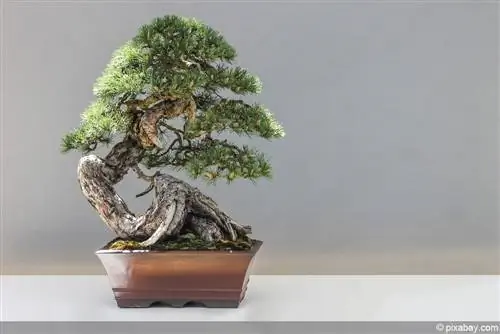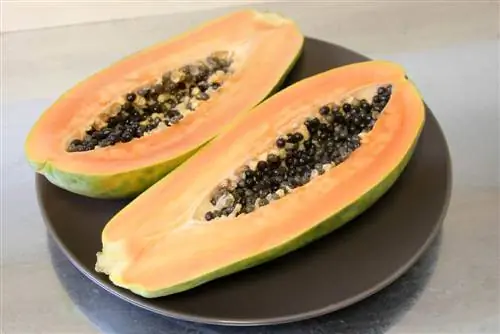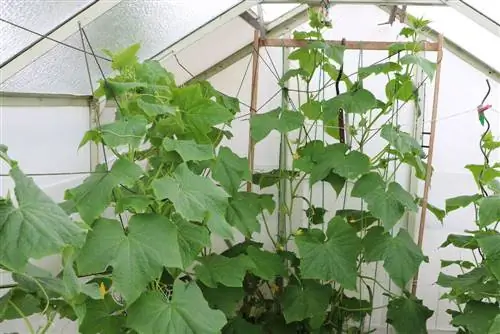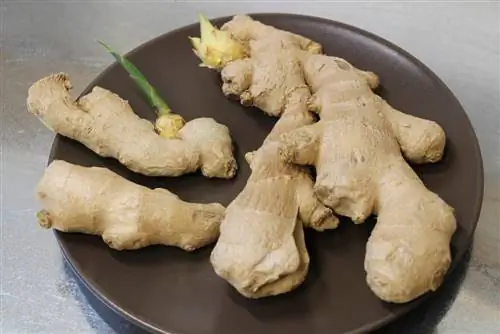- Author admin [email protected].
- Public 2023-12-17 03:39.
- Last modified 2025-01-24 12:45.
If you like exotic plants, you will love the Sharon fruit. The decorative persimmon tree is also finding more and more fans in these latitudes. Planting outdoors is only possible in very mild climates as the plant is not hardy. Therefore, in these latitudes it is usually cultivated in pots. Seeds for growing your own are available commercially. With the right know-how, this isn't difficult at all.
Win seeds
Unfortunately, there are usually no seeds in the persimmon fruits that are offered for pure consumption in local supermarkets. These were bred for easier consumption and greater enjoyment. But every now and then it is possible that a fruit still has seeds. However, if you want to grow the Sharon fruit yourself from seeds, it is easier to get them from well-stocked garden shops or online via the Internet. However, if you already have your own persimmon tree, you can definitely look forward to new seeds from the fruits formed here. This is what the seeds look like:
- maroon color
- almond-shaped
- the seeds are about one centimeter tall
Tip:
If seeds have actually been found in a persimmon fruit, then after eating the pulp you can immediately use them for your own cultivation. To do this, they are completely removed from the pulp and quickly placed in the ground.
Preparation
If persimmon seeds were found in the fruit, bought in stores or ordered online, then they should be planted in the ground as quickly as possible. The purchased seeds have already been cleaned, those found in purchased or home-grown fruits still need to be completely cleaned of the pulp. Then proceed as follows:
- a bowl of lukewarm water
- Put in seeds
- soak for a day
- only then add it to the germination substrate
The seeds are placed in the seed pot; they should not be too close together. Otherwise, the roots formed after the germination period could get caught in one another and be damaged during later transplanting. The seeds are pressed about a centimeter deep into the soil and lightly covered with the coconut substrate.
Substrate for germination
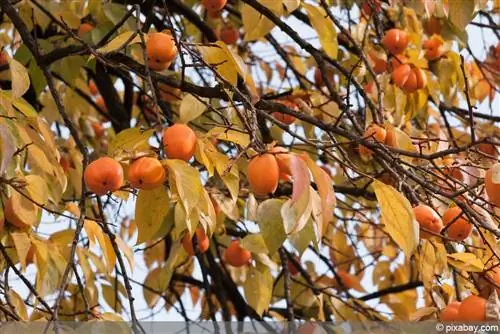
A special substrate is required for the seeds of the Sharon fruit to germinate. This is only intended for the germination period until the first roots have formed. Coconut substrate, which is available ready-made from well-stocked garden shops, has proven useful for this purpose. To ensure that there are no germs, fungi or pests in the finished substrate, which unfortunately happens more often with purchased soil, it should be prepared as follows before use:
- fireproof glass keys with lid
- Fill substrate
- this should be slightly moist
- heat for at least 15 minutes
- to 160° in the oven or microwave
- Do not close the container tightly
- the water vapor would cause the lid to explode
- However, put the lid on lightly
- otherwise too much water vapor will escape
Once the substrate has cooled completely after heating, it is filled into the cultivation pots for further use for the germination of the persimmon seeds.
Germination time location
Once the seeds have been planted in the substrate, then you have to wait. Above all, the vessel needs a very warm place, which does not necessarily have to be bright. But even if the temperatures for germination can be up to 40° Celsius, a place directly on the heater is not suitable for this. During the germination period the location should look like this:
- place in a very warm place
- The boiler room is suitable for this
- a place at the hot water branch of a heater
- is often found in apartment buildings in the basement
- heatable indoor greenhouse
- warm winter garden
Before the right location is found here, the selected room should be observed in advance with a thermometer for at least one day, i.e. 24 hours, to ensure that the temperature remains consistently within the desired range.
Tip:
If no suitable location has been found for such warm temperatures and there is no heated indoor greenhouse available, then you can also use a heat lamp that is aimed directly at the pot to achieve the appropriate warmth.
Germination time
Once the right location has been found for the container with the germination soil and the seeds, then a few things have to be taken into account during the germination period so that new small persimmon trees can develop from them. The substrate must be kept evenly moist, but without adding too much water. This would mean that the persimmon seeds could rot, making germination impossible. Furthermore, the following should be noted during the germination period, which can take a little longer:
- Put a plastic bag over the growing pot
- how to retain moisture better
- alternatively, cut off the neck of the PET bottle
- If the pot is the right size, put it the other way around
- Air the cultivation pot daily
- otherwise mold will form on the earth
- After one to four weeks the first roots appear
- this depends on the ground temperature
- the warmer it is, the faster roots form
Tip:
If an indoor greenhouse is used, there is enough air circulation and there is usually no risk of mold forming on the ground.
cultivation

After the seeds have successfully germinated, the cultivation follows. In order to thrive and grow well, the Sharon fruit needs a different substrate than that used during the germination period. A nutrient-poor and loose soil is now required; potting soil can certainly be used here. This should also be heated in advance to such an extent that no more germs or pests can be found in it. The potting soil can also be mixed with some coconut substrate. However, it is wrong to leave the seeds in the germination substrate after germination. After detecting the first root formation, you should proceed as follows:
- Fill growing soil into small pots
- alternatively use a seed tray
- Carefully remove seeds with roots from the coconut substrate
- drill a small hole in fresh soil
- Put seeds in it
- Roots must protrude downwards
- cover about one centimeter with soil
Tip:
If the seed is buried more than one centimeter deep in the soil, the seedling may not be able to push the seed capsule out of the soil. If the seedling does not succeed in this due to too much soil, then no new Sharon fruit will form.
Location for cultivation
A warm location is now recommended for cultivation, similar to the germination period. However, it is now ideal to keep the growing pot not only warm, but also bright. Because as soon as the first seedlings appear above the ground, they need brightness. The following locations are now ideal:
- do not turn on the heater
- it can get too warm here
- Heated indoor greenhouse is ideal
- otherwise on a bright window
- Equalize the temperature with a heat lamp
- never place in direct sun
- otherwise the seedlings will burn immediately
- cultivation would then no longer be successful
Tip:
Only when the persimmon tree has grown and become older should it slowly be accustomed to direct sunlight.
Pouring
The seedling needs a lot of moisture, but waterlogging should be avoided at all costs. It can also happen if water is poured onto the growing pot with a watering can that the seedling will be washed further underground, which could damage further growth. Therefore, a lot of sensitivity is required here. When watering, you should pay attention to the following:
- if with watering can only with a small opening
- carefully let the water run in around the edge of the pot
- never directly on or next to the seedling
- the wet earth could otherwise cover it
- The seedling would then have no chance of growing upwards
- Ideally the soil is just sprayed
- dust the soil with water from the spray bottle
Fertilize
The seedling is not fertilized for the first few weeks of cultivation. Because the small, young plants still feed themselves from the seed core. But after two months the first fertilization should begin:
- use commercially available liquid fertilizer
- once a week with watering water
- always only a quarter of the recommended amount
- otherwise the small plant will be over-fertilized
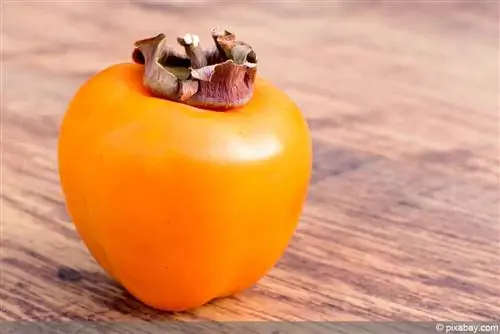
Sharon fruits can be grown from seeds all year round, as they need to be kept warm and are therefore in a protected place. Young plants that have just emerged from a germ therefore continue to grow in winter and do not require hibernation in the first year. Therefore, fertilization continues even in winter if the plant is in a warm and bright place.
Repotting
The young plant can remain in its growing pot until the ball is completely rooted. But then it is time to repot the Sharon fruit into a new, larger container with which it can then move to its chosen final location. The following should also be taken into account:
- the persimmon tree does not tolerate waterlogging
- therefore create drainage over the drain hole
- Use stones, gravel or pottery shards
- here plant fleece
- fill half of prepared soil
- Remove the plant from the nursery pot
- use carefully
- fill in remaining soil
- pour well
For further cultivation of the newly grown Sharon fruit, a loamy and slightly acidic soil that is well permeable to water is chosen.


